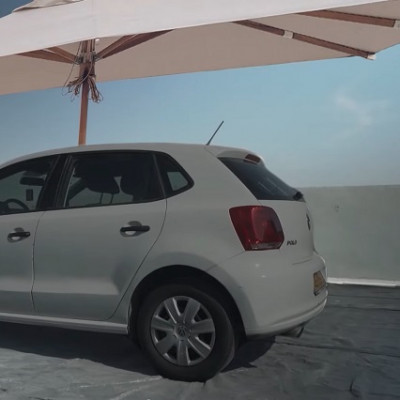
2022-06-08
Visited : 1218
A newly-developed coating can reduce cabin temps by as much as 70 percent without the need for shade or AC.
Saving energy via environmental conditioning in cars is extremely important. Running the air conditioning or heater is inefficient, and in EVs, it's an even bigger factor in terms of energy loss. It's why automakers are using heat pumps as range extenders on battery-electric vehicles to retain said energy for propulsion. Now, a very cool (literally) bit of quantum physics means a film coating on the dash and roof of a car could work similar to a black hole, and replace air conditioning by using the energy from sunlight to cool things down.
If that sounds impossible then allow me to explain: a startup called SolCold has managed to find a way to use anti-Stokes fluorescence, which is a phenomenon where (under some very specific circumstances) photons can react with a surface that makes them leave with more energy than they encountered it with. So basically it beams the energy from sunlight back stronger, turning energy loss into a cooling process.
The thing is, anti-Stokes fluorescence isn't very easy to make happen. It's one of those laboratory and space tech things that doesn't really get out into the wild because it requires some very specific conditions. Needless to say, I was pretty amazed to see that SolCold had manufactured a film coating that produces the phenomenon and can be laid onto the roof and dash of a regular old VW hatchback.
If you don't want to get into the physics bit then here's all you need to know: when the film coating was put on the VW Polo, in a partnership with Volkswagen's Konnekt research, SolCold took the specially coated car and two control vehicles out into the desert. In full sunlight, the coating achieved a cooling effect between 53.6 and 57.2 Fahrenheit, compared to the uncoated car.
Amazingly, the coating kept the car sitting in direct sun cooler than the car placed in the shade; that's a very real, very rad cooling effect that could transform the need to have the aircon blasting when you're driving down a highway on a hot day. SolCold told me that depending on the size of the car's cabin, it could reduce the temperature inside by as much as 20 to 70 percent.
Alright, for the nerds still with me let's get excited about this. The film coating is already in a prototype phase and SolCold told me that it can head for production later this fall. Of course, SolCold couldn't tell me what they're using to make the film but they did confirm it has no hazardous stuff and no rare earth materials, which is a win in these metal-and-mineral-strapped times.
Developing the film took three years of lab research and this is just the first generation, reaching roughly 100W of cooling per 3.3 square feet. SolCold told me the idea is to make a more effective film as well as develop it into different products, like a yarn that could be used to make fabrics. Imagine getting into your car after it's been sitting in a sunny lot and not immediately burning your butt off.
The really cool bit is that the SolCold film partially does what it does with technology from black holes. A "perfectly black body," in physics terms, is something that absorbs so much of the energy around it that it works a little bit like a tiny black hole. SolCold's film uses three layers of smart filtration, black body emissivity, and the anti-Stokes conversion layer, working on different wavelengths to do what it does.
And no, just because it's talking about fluorescence doesn't mean it's going to reflect stuff back in your eyes. Each photon hits a different nanostructure and then flies off again in any direction, so the energy is diffused without any dazzling.
Volkswagen has already committed to using the SolCold film in a concept car and with production so close this could be something in production cars really soon, though probably in limited quantities at first.
Read the original article on The Drive.